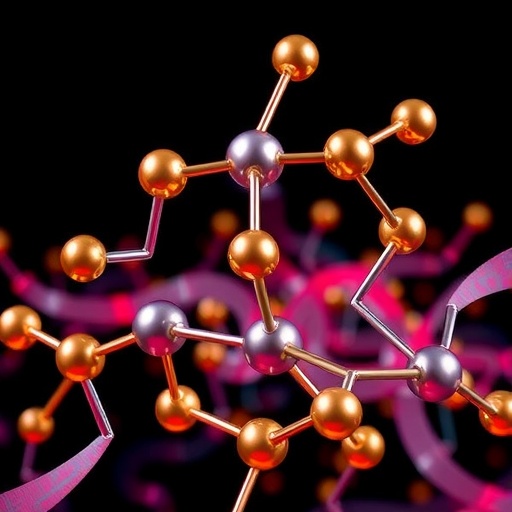In the ever-evolving landscape of environmental science, optimizing detection methodologies is critical for accurately measuring complex chemical interactions. This imperative need is underscored in recent research led by Wang Deng, Xian Lv, and Chen Lu, which proposes an advanced approach to measure nickel (Ni(II))-organic complexes. As the demand for precise environmental monitoring continues to climb, their innovative study not only draws on theoretical frameworks but also employs practical experimentation and robust modeling techniques to enhance the measurement’s accuracy.
At the heart of this investigation lies the challenge associated with ferric substitution in the Ni(II)-organic complex measurement. Previous efforts in this domain have often yielded results plagued by calibration uncertainties and specificity issues. The team meticulously dissected existing methods, identifying the intricate dynamics at play when ferric ions interfere with nickel complex formation.
The research begins with a thorough examination of the physicochemical properties of Ni(II)-organic complexes. Understanding these properties is paramount for establishing a baseline for any detection method. Nickel’s acute propensity to form stable complexes with various organic ligands introduces layers of complexity often overlooked in simpler detection models. The authors highlight that this complexity can lead to significant variations in the detection outcomes, depending on the conditions under which the measurements are taken.
To devise a solution, Deng and colleagues employed simulations to model various scenarios involving ferric substitution. By varying parameters such as pH, concentration, and temperature, the researchers were able to pinpoint the precise conditions under which ferric ions exert the most deleterious effects on Ni(II) detection. Their simulation not only confirmed existing hypotheses but also brought to light novel interactions previously unaccounted for in traditional methodologies.
After solidifying their theoretical approach through simulations, the research team transitioned to practical experiments. They designed a series of controlled laboratory tests to validate their findings. These experiments were meticulously crafted to mimic real-world conditions, ensuring the relevance of their outcomes. The results from these trials served as a critical turning point, affirming the team’s theoretical predictions and allowing for further refinement of the proposed detection methods.
Optimization emerged as a central theme throughout their research. The authors detail a stepwise revision of the experimental setup, enhancing measurement protocols to minimize the potential for ferric interference. These enhancements include the introduction of specific buffering agents and the adjustment of parameters guiding complex formation, thereby dramatically improving the robustness of the detection method.
One significant outcome of this research was the identification of a calibration curve that could be used across multiple scenarios, allowing for the standardization of measurement techniques in diverse environmental contexts. This step not only streamlines the process for researchers but also holds considerable promise for regulatory compliance in monitoring nickel levels across industrial applications.
Furthermore, the study outlines the implications of accurate Ni(II) detection on environmental monitoring and public health. As nickel is often present in industrial byproducts, ensuring its safe levels in the environment is critical for preventing ecological and human health hazards. By improving detection methods, this research paves the way for better regulatory practices and fosters greater transparency in environmental impact assessments.
Moreover, the integration of modeling techniques heralds a new era in environmental science research. The authors advocate for the continuous employment of simulations alongside experimental work. They argue that such integration can expedite the discovery of effective methodologies, ultimately elevating the field’s capacity to respond to emerging environmental challenges.
Innovative methodologies like those presented in this research are not only vital for the current scrutiny of nickel levels but also serve as a template for future investigations into other complex metal-organic interactions. The ongoing need for innovative and accurate measurement techniques is evident across various domains of environmental science, where the stakes can include biodiversity conservation and public health welfare.
The impact of this work resonates beyond the laboratory; it underscores the growing interconnectivity of environmental science disciplines. By employing a multidisciplinary approach, the research pushes the boundaries of traditional environmental monitoring, emphasizing collaboration, simulation, and experimentation as keys to addressing critical environmental issues.
As the field progresses, the study conducted by Deng, Lv, and Lu highlights the pressing need for innovative thinking in scientific research and monitoring practices. Their findings not only contribute valuable insights into nickel detection but also reinforce the overarching message that with the right methodologies, even the most complex environmental determinants can be untangled.
In conclusion, the research presented by the team stands as a significant contribution to environmental monitoring. Their optimized detection methods for Ni(II)-organic complexes ensure that scientists and regulators alike can approach nickel-related challenges with greater accuracy and confidence. As we move forward, one can only hope that such efforts will inspire further advancements in environmental science, securing a healthier planet for generations to come.
Subject of Research: Optimization of detection methods for Ni(II)-organic complexes
Article Title: Post ferric-substitution detection method optimization for Ni(II)-organic complexes measurement: Simulation, experimentation, and modeling.
Article References:
Deng, W., Lv, X., Lu, C. et al. Post ferric-substitution detection method optimization for Ni(II)-organic complexes measurement: Simulation, experimentation, and modeling.
Environ Monit Assess 197, 1203 (2025). https://doi.org/10.1007/s10661-025-14658-3
Image Credits: AI Generated
DOI: 10.1007/s10661-025-14658-3
Keywords: Nickel (Ni(II)), organic complexes, ferric substitution, detection methods, environmental monitoring, simulation, experimentation, modeling, calibration curve, public health.




